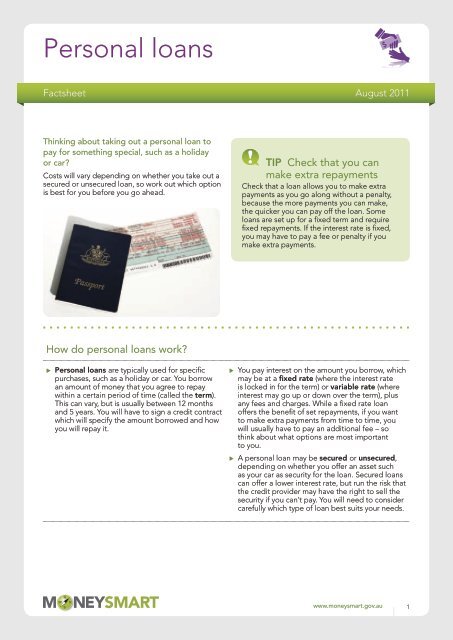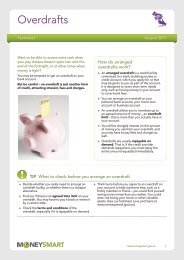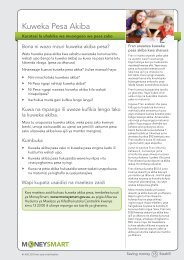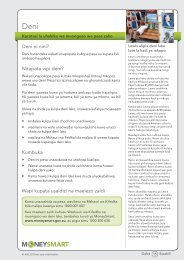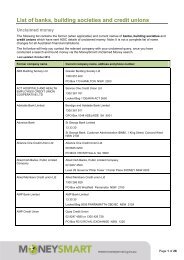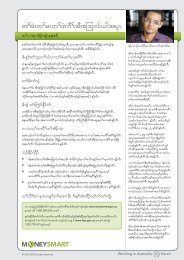Personal loans - MoneySmart
Personal loans - MoneySmart
Personal loans - MoneySmart
Create successful ePaper yourself
Turn your PDF publications into a flip-book with our unique Google optimized e-Paper software.
<strong>Personal</strong> <strong>loans</strong><br />
Factsheet<br />
August 2011<br />
Thinking about taking out a personal loan to<br />
pay for something special, such as a holiday<br />
or car?<br />
Costs will vary depending on whether you take out a<br />
secured or unsecured loan, so work out which option<br />
is best for you before you go ahead.<br />
TIP Check that you can<br />
make extra repayments<br />
Check that a loan allows you to make extra<br />
payments as you go along without a penalty,<br />
because the more payments you can make,<br />
the quicker you can pay off the loan. Some<br />
<strong>loans</strong> are set up for a fixed term and require<br />
fixed repayments. If the interest rate is fixed,<br />
you may have to pay a fee or penalty if you<br />
make extra payments.<br />
How do personal <strong>loans</strong> work?<br />
XX<br />
<strong>Personal</strong> <strong>loans</strong> are typically used for specific<br />
purchases, such as a holiday or car. You borrow<br />
an amount of money that you agree to repay<br />
within a certain period of time (called the term).<br />
This can vary, but is usually between 12 months<br />
and 5 years. You will have to sign a credit contract<br />
which will specify the amount borrowed and how<br />
you will repay it.<br />
XX<br />
You pay interest on the amount you borrow, which<br />
may be at a fixed rate (where the interest rate<br />
is locked in for the term) or variable rate (where<br />
interest may go up or down over the term), plus<br />
any fees and charges. While a fixed rate loan<br />
offers the benefit of set repayments, if you want<br />
to make extra payments from time to time, you<br />
will usually have to pay an additional fee – so<br />
think about what options are most important<br />
to you.<br />
XX<br />
A personal loan may be secured or unsecured,<br />
depending on whether you offer an asset such<br />
as your car as security for the loan. Secured <strong>loans</strong><br />
can offer a lower interest rate, but run the risk that<br />
the credit provider may have the right to sell the<br />
security if you can’t pay. You will need to consider<br />
carefully which type of loan best suits your needs.<br />
www.moneysmart.gov.au<br />
1
<strong>Personal</strong> <strong>loans</strong><br />
TIP How to borrow wisely<br />
XX<br />
Organise your loan before you go shopping.<br />
XX<br />
As with any credit product, compare interest<br />
rates, fees and charges to get the best deal.<br />
XX<br />
If you want to borrow a small amount (less than<br />
$5000), you may have difficulty getting a personal<br />
loan from a bank or other mainstream credit<br />
provider:<br />
XX<br />
XX<br />
Some credit providers offer small personal<br />
<strong>loans</strong> in return for comparatively high interest<br />
rates and fees. See our factsheet Payday<br />
<strong>loans</strong> and other high-cost credit at<br />
www.moneysmart.gov.au for what to watch<br />
out for with these kinds of <strong>loans</strong>.<br />
Consider using a credit card, which<br />
may be a better option than other<br />
<strong>loans</strong> available to you. See our factsheet<br />
Credit cards and store cards at<br />
www.moneysmart.gov.au.<br />
XX<br />
If you are on a low income, you may be<br />
eligible for a no or low-interest loan. See<br />
our factsheet No or low-interest <strong>loans</strong> at<br />
www.moneysmart.gov.au to find out more.<br />
You can also call our Infoline on 1300 300 360 and<br />
we’ll send any of our factsheets to you for free.<br />
XX<br />
Try to pay your loan off quickly to reduce<br />
the interest you have to pay, subject to the<br />
conditions of your loan.<br />
XX<br />
Find out whether you will be charged any default<br />
fees and/or interest if you can’t meet the loan<br />
repayments.<br />
XX<br />
Contact the credit provider early if you have<br />
trouble meeting loan repayments to discuss your<br />
options (see step 5 on page 5).<br />
XX<br />
Get help from a free financial counsellor or<br />
free legal service if you can’t pay your debts.<br />
See our factsheet Can’t pay your debts? at<br />
www.moneysmart.gov.au.<br />
Choosing a personal loan<br />
Secured loan<br />
How it works<br />
XX<br />
You offer an asset, such as your car, as security or<br />
collateral for the loan.<br />
What to watch out for<br />
XX<br />
If you don’t make repayments, the credit provider<br />
can repossess and sell your asset to get its money<br />
back (without going to court).<br />
Unsecured loan<br />
How it works<br />
XX<br />
You do not need to have an asset to offer as<br />
security. Unsecured <strong>loans</strong> are usually harder<br />
to get, as you need to convince credit providers<br />
that your credit worthiness and financial position<br />
are good enough for them to give you a loan<br />
without you having an asset to sell if you can’t<br />
pay your debt.<br />
What to watch out for<br />
XX<br />
If you fail to repay the loan, the credit provider<br />
can still take you to court in order to sell your<br />
property and recover the money.<br />
XX<br />
Interest rates are usually higher than for secured<br />
<strong>loans</strong>, since the credit provider is taking a bigger<br />
risk.<br />
www.moneysmart.gov.au 2
<strong>Personal</strong> <strong>loans</strong><br />
Shopping around for the best deal<br />
TIP<br />
Interest rates and fee and charges can stack<br />
up, so do your homework before you sign<br />
up for a loan.<br />
What is the term of<br />
the loan?<br />
What is the Annual<br />
Percentage Rate<br />
(APR)?<br />
What are the fees and<br />
charges?<br />
What are the credit<br />
contract terms and<br />
conditions?<br />
XX<br />
A loan may seem more attractive than other forms of credit because it offers a<br />
lower interest rate, spread over a longer term. But it could end up costing you<br />
more by the end of the loan term. Remember, the longer the term, the more<br />
interest you will pay.<br />
XX<br />
When comparing loan options, make sure that the term of the loan is the<br />
same for each loan you are comparing (for example, compare a five-year loan<br />
with other five-year <strong>loans</strong>). That way you’ll get a true picture of the difference<br />
in interest rates.<br />
XX<br />
The Annual Percentage Rate (APR) is the percentage interest your bank or<br />
other credit provider charges you to borrow money – this is usually referred to<br />
as the listed or published rate. Once you know the published rate, you can<br />
compare personal <strong>loans</strong> offered by different credit providers.<br />
XX<br />
If you multiply the published rate by the term, you will get an idea of how<br />
much interest you will have to pay over the life of the loan (bearing in mind<br />
that fees and charges are in addition to this).<br />
XX<br />
Credit providers may also advertise comparison rates, which include the APR<br />
plus the main fees and charges, to make it easier to compare the total cost<br />
of different <strong>loans</strong>. So while one loan may have a lower published rate (APR),<br />
it may have a higher comparison rate because it carries higher fees – and so<br />
would cost you more overall.<br />
XX<br />
Banks, building societies and credit unions usually offer cheaper interest rates<br />
than finance companies.<br />
XX<br />
Check if you will be charged a loan application fee (may be as high as $250),<br />
and whether there are any monthly service fees charged (may range up to $10<br />
per month).<br />
XX<br />
Most credit providers prefer you to make monthly payments by direct debit<br />
from your bank account so you don’t miss any payments. Check whether your<br />
bank charges a late fee so you know what to expect if you do miss a payment.<br />
If you are paid on a regular date, set up the direct debit for the day after<br />
payday to minimise the chance of not having enough money in your account.<br />
XX<br />
Ask if there are penalties for paying off the loan in full ahead of the agreed<br />
term. You need to offset this against how much you’d save in interest by<br />
paying it out early.<br />
XX<br />
Always check the terms and conditions of any loan contract before you go<br />
ahead.<br />
www.moneysmart.gov.au 3
<strong>Personal</strong> <strong>loans</strong><br />
Six steps to smarter borrowing<br />
Step 1. <br />
Work out if you<br />
can afford to<br />
borrow<br />
XX<br />
Before you borrow money or consider refinancing, use our budget planner at<br />
www.moneysmart.gov.au to see exactly where you spend your money and how<br />
much you can afford in repayments.<br />
XX<br />
Save up as much as you can, so you can borrow less and save on interest.<br />
XX<br />
Remember to allow for interest rate rises and anything that might affect your future<br />
income (such as changing jobs).<br />
Step 2. <br />
Shop around<br />
for the best<br />
deal<br />
XX<br />
If you decide to borrow, take time to compare interest rates, product features,<br />
and fees and charges. Even a small difference in the interest rate can make a big<br />
difference to what you have to pay.<br />
XX<br />
Shop around online to compare products or use our multi-loan calculator<br />
at www.moneysmart.gov.au.<br />
XX<br />
Research published by the independent consumer group CHOICE can also help you<br />
find the right product for your needs and budget – see www.choice.com.au.<br />
Step 3. <br />
Know who and<br />
what you’re<br />
dealing with<br />
XX<br />
Anyone who wants to engage in credit activities (including brokers) must be licensed<br />
with ASIC or be an authorised representative of someone who is licensed. If they<br />
aren’t, they are operating illegally.<br />
XX<br />
There is currently an exemption from licensing for credit assistance provided<br />
through some businesses (for example, retail stores and car yards). While the store<br />
may be exempt, the actual credit provider must still be licensed. If you are unsure<br />
who the credit provider is, ask the person you are dealing with to point out the<br />
name in your credit contract.<br />
XX<br />
To find out if a credit provider is licensed, visit www.moneysmart.gov.au<br />
or call ASIC’s Infoline on 1300 300 630.<br />
XX<br />
Anyone engaging in credit activities (for example, by providing credit or assistance<br />
to you) must give you either a credit guide (with information such as their licence<br />
number, fees and details of your right to complain) or a written notice with details of<br />
your right to complain about their activities.<br />
Step 4.<br />
Keep up<br />
with your<br />
repayments<br />
XX<br />
Keep your repayments up-to-date to avoid penalty fees.<br />
XX<br />
Make extra payments when you can, to save on interest (subject to the conditions of<br />
your loan).<br />
Step 5. <br />
Get help if you<br />
can’t pay your<br />
debts<br />
XX<br />
Act quickly if you are having trouble making repayments. It may be difficult to face<br />
the problem, but ignoring it will only make things worse.<br />
XX<br />
If you can’t make the full repayment, pay what you can. Contact your credit provider<br />
without delay.<br />
XX<br />
If you are experiencing financial difficulties, you have the right to apply to the credit<br />
provider for a hardship variation. If the credit provider refuses, you can complain<br />
to its independent dispute resolution scheme for a variation on the grounds of<br />
hardship (see step 6 below).<br />
XX<br />
There are places you can go for help – visit www.moneysmart.gov.au for sample<br />
letters and information about support services such as financial counselling and<br />
legal assistance, call the National Financial Counselling Hotline on 1800 007 007<br />
or call ASIC’s Infoline on 1300 300 630.<br />
XX<br />
See our factsheet Can’t pay your debts? at www.moneysmart.gov.au.<br />
www.moneysmart.gov.au 4
<strong>Personal</strong> <strong>loans</strong><br />
Step 6. <br />
Complain if<br />
things<br />
go wrong<br />
XX<br />
Try to resolve your problem with your credit provider first.<br />
XX<br />
If you aren’t satisfied, take your complaint to your provider’s independent dispute<br />
resolution scheme. This will be either the Financial Ombudsman Service (FOS)<br />
at www.fos.org.au or the Credit Ombudsman Service Ltd (COSL) at<br />
www.cosl.com.au. Both schemes can be reached by calling 1300 780 808.<br />
X X If you think that a credit provider has acted unlawfully or in a misleading way, you can<br />
complain to ASIC online at www.asic.gov.au or call ASIC’s Infoline on 1300 300 630.<br />
www.moneysmart.gov.au 5
<strong>Personal</strong> <strong>loans</strong><br />
www.moneysmart.gov.au<br />
ASIC Infoline: 1300 300 630<br />
Disclaimer<br />
Please note that this is a summary giving you basic information about a particular topic. It does not cover the whole of the relevant law regarding<br />
that topic, and it is not a substitute for professional advice.<br />
© Australian Securities and Investments Commission 2011<br />
www.moneysmart.gov.au<br />
6


